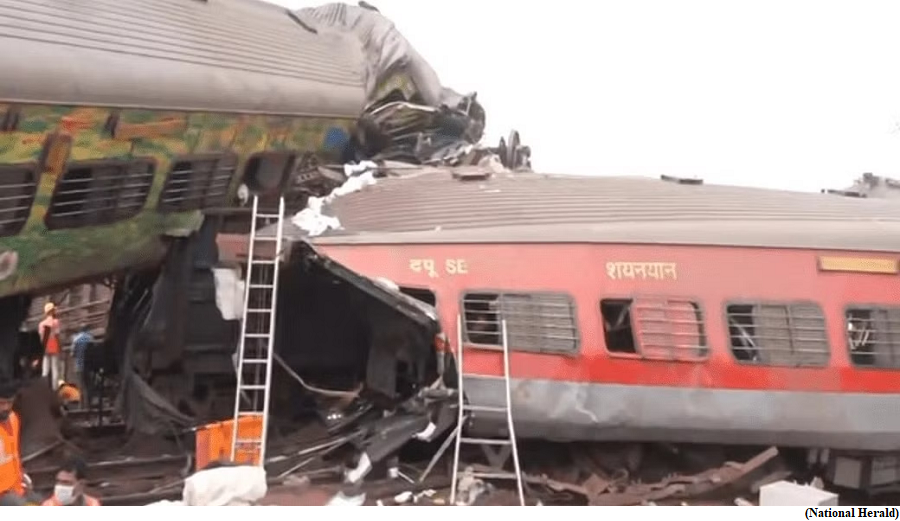Odisha train collision, Solutions that don’t take Railways back to business-as-usual (GS Paper 3, Infrastructure)

Context:
- The tragic death of nearly 300 passengers in a train accident has drawn attention to the safety preparedness of the Indian Railways, at least for the moment.
Knee jerk solutions:
- The much-touted Kavach, the so-far ignored CAG report on safety and of course, the problem of congestion on the trunk routes of the system.
- The prescriptions are on expected lines cover the network with Kavach quickly, pay attention to funds for safety and their utilisation and in the medium to long run increase capacity so that there is enough room for passenger-carrying trains, separate corridors for freight trains and sufficient time for maintenance.
- The problem with all these solutions is they are promises for better times in the future and no one knows when these good times will or could come.
Issues:
Highly-congested trunk routes:
- First, the issue of highly-congested trunk routes, which carry most of the freight and passenger traffic. This does place inordinate pressure, both on operations and maintenance.
- To state the obvious, excess time for maintenance means sluggish operations (immediately observed through quantified indices), while focussing on train operations without sufficient time for maintenance means a more failure-prone system (not clearly observable degradation of the assets).
Optimal balance between train operations on a track and maintenance of the track:
- A system of providing traffic blocks in the passenger timetable already exists. Time is allocated for maintenance along a route, where no trains are scheduled – a time corridor of two to four hours during any part of the day. The zero-based timetabling exercise undertaken a few years ago worked with this as a mandatory feature. Earlier, this was not a complete solution because of the discretionary element in the utilisation of this block period.
- The reason for providing discretion was to give operations sufficient room to deal with the contingencies arising from passenger-carrying trains running out of schedule or to push unscheduled freight trains, all to meet stiff daily targets of punctuality and movement.
- Today, it is still not a complete solution even though blocks are granted as required by the maintenance departments. What is lacking is a mutually agreed annual plan between the maintenance departments and the operations department for coordinated use of the traffic block.
- It is possible to make an annual plan of maintenance (and renewal/new construction) and map it on the block corridors so that all three infrastructure assets (track, overhead electrical equipment and signalling equipment) are maintained.
- Such a plan was successfully implemented in a division and the benefits were evident. Despite attempts to proliferate this across the network, it did not happen. There could not be a better time to re-introduce this system network-wide, a workable plan can be made for each division three months from now which makes it an attractive immediate measure.
Is it possible to internalise the paper memo process and the physical locks and seals as part of the electronic system?
- The second solution is an untried one but more directly connected to the recent mishap. The main story emerging from published sources is that there could have been tampering with the signalling equipment – whether wanton or due to negligence is yet to be established.
- It has been suggested that the immense pressure on the field staff at highly congested routes leads to the adoption of shortcuts, resulting in fail-safe interlocking systems getting invalidated.
- The current practice of a disconnection memo to the station master from the signal maintainer followed by a connection memo is not strictly followed. The staff is under severe strain to minimise failures and/or ensure that trains are not detained due to a failure.
- In some cases, the incentives of the operating staff are aligned with the signalling staff, resulting in collusion in the adoption of shortcuts. The two-agency authorisation for opening the relay room, where all the sensitive equipment resides, is violated.
- Other equipment like junction boxes and point machines are protected with seals but again these can be broken. During safety inspections or when a mishap occurs these violations are noticed and severe action is taken against the errant staff.
- The Balasore accident shows that the price of such violations can be immense and punishments do not seem to be sufficient deterrents.
Way Forward:
- The second idea may require some time, especially to develop the necessary software and implement it in the field. But it could resolve the dichotomy between the fail-proof electronic system and the error-prone manual system.
- The basic idea is to bring in greater discipline at the systemic level and move away from a reliance on the ingenuity of the individual.


